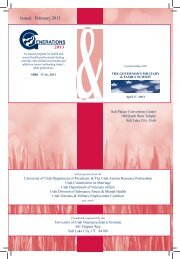The Utah Marriage Handbook - Stronger Marriage
The Utah Marriage Handbook - Stronger Marriage
The Utah Marriage Handbook - Stronger Marriage
Create successful ePaper yourself
Turn your PDF publications into a flip-book with our unique Google optimized e-Paper software.
Determine the roles of the primary parent and<br />
the secondary parent. Parenting usually includes<br />
having disciplinary power. A stepparent should<br />
take his/her time with this, especially with older<br />
children and teens. <strong>The</strong> biological parent should<br />
remain the primary disciplinarian in the early<br />
years of stepfamily development. When both<br />
biological and stepparent are present, discipline<br />
is best administered by the biological parent<br />
until the child is ready to accept the stepparent<br />
as a disciplinarian. When the biological parent is<br />
not present, the stepparent operates much like a<br />
babysitter or an aunt or uncle. You are an adult<br />
in charge, but you are not the parent. You enforce<br />
the rules of the house; for example, you say, “This<br />
is the rule of the house. Homework is done<br />
before television.”<br />
You can respond to “You’re not my parent,” with<br />
“Yes. You are right. You have a mom and a dad,<br />
and I’m not going to replace either one of them.<br />
You and I are going to get to know each other a<br />
bit at a time. Meanwhile, though, I’m the adult in<br />
charge here tonight, and the rule is no television<br />
until homework is done.”<br />
As children get more comfortable, a stepparent<br />
can become more of a primary disciplinarian.<br />
Follow the child’s lead—do not force parental status.<br />
As time goes by, you and your spouse can help<br />
the children understand that just as a parent<br />
can have more than two children and care for<br />
each in a special way, so can a child have more than<br />
two parents and respect and care for each in a<br />
special way.<br />
A rule of thumb is that a child’s age is the<br />
number of years it may take for the stepparent<br />
to transition into full parental status; therefore,<br />
for children who are adolescents when the<br />
stepfamily forms, it is probaby not realistic to<br />
expect that a stepparent will ever serve in a full<br />
parental role—and that’s okay. <strong>The</strong> stepparent<br />
can still be an important, loving, respected adult<br />
in the child’s life.<br />
Special Topics / Remarriages<br />
Even if the children are young when the<br />
stepfamily is formed, it is not always a straight<br />
path toward two primary parents. It is not<br />
uncommon for a couple to choose to revert to<br />
primary/secondary parental roles during adolescence.<br />
This can serve to protect the stepparent/stepchild<br />
relationship. Adolescence is usually a challenging<br />
time for parents, and the biological parent/child<br />
relationship is usually more resilient in the face of<br />
these challenges.<br />
Remember, though, that secondary parenting<br />
doesn’t mean “second-class.” This is an important<br />
issue for stepparents. Within the implementation<br />
of these suggestions for the primary/secondary<br />
parenting team in stepfamilies, the biological<br />
parent should ensure that the stepparent is<br />
treated respectfully.<br />
Learn about child development. If you are not<br />
a biological parent or if your own children are<br />
younger than your spouse’s children, read up<br />
on child development. Realistic expectations for<br />
children’s behavior is an important starting point<br />
when dealing with children. It is not an excuse for<br />
inappropriate behavior, but it often provides<br />
some understanding of what might be going on<br />
and what the child’s capabilities are.<br />
This information might help you determine<br />
what are stepfamily issues and what are<br />
developmental issues. Often, stepparents assume<br />
that inappropriate behavior is directed at them<br />
because they are the stepparent. If you look closer,<br />
the biological parent is probably receiving similar<br />
treatment, and the child’s developmental stage<br />
has more to do with the behavior.<br />
Develop the relationships in the family oneto-one.<br />
In the early years of the stepfamily,<br />
the stepparent should focus on building a<br />
relationship with each of the stepchildren<br />
individually. Although doing things as a family<br />
seems like a good idea, for stepfamilies, it’s<br />
actually better to plan one-to-one activities to<br />
build and strengthen relationships. Try to find<br />
Strategies for Stepparenting • 33




